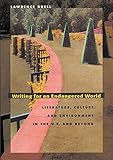Writing for an Endangered World : Literature, Culture, and Environment in the U.S. and Beyond / Lawrence Buell.
Material type: TextPublisher: Cambridge, MA : Harvard University Press, [2009]Copyright date: ©2003Description: 1 online resource (384 p.)Content type:
TextPublisher: Cambridge, MA : Harvard University Press, [2009]Copyright date: ©2003Description: 1 online resource (384 p.)Content type: - 9780674029057
- American literature -- History and criticism
- Criticism -- American -- General
- Ecology in literature
- English literature -- History and criticism
- Environmental policy in literature
- Environmental protection in literature
- Landscapes in literature
- Littérature américaine -- Histoire et critique
- Littérature anglaise -- Histoire et critique
- Nature conservation in literature
- Nature in literature
- LITERARY CRITICISM / American / General
- 810.9/355 23
- PS169.E25 B84 2001eb
- online - DeGruyter
| Item type | Current library | Call number | URL | Status | Notes | Barcode | |
|---|---|---|---|---|---|---|---|
 eBook
eBook
|
Biblioteca "Angelicum" Pont. Univ. S.Tommaso d'Aquino Nuvola online | online - DeGruyter (Browse shelf(Opens below)) | Online access | Not for loan (Accesso limitato) | Accesso per gli utenti autorizzati / Access for authorized users | (dgr)9780674029057 |
Browsing Biblioteca "Angelicum" Pont. Univ. S.Tommaso d'Aquino shelves, Shelving location: Nuvola online Close shelf browser (Hides shelf browser)

|

|

|

|

|

|

|
||
| online - DeGruyter Reinventing Russia : Russian Nationalism and the Soviet State, 1953-1991 / | online - DeGruyter The Southern Past : A Clash of Race and Memory / | online - DeGruyter Catholic Schools and the Common Good / / | online - DeGruyter Writing for an Endangered World : Literature, Culture, and Environment in the U.S. and Beyond / | online - DeGruyter Emerson / | online - DeGruyter Feminism and Its Discontents : A Century of Struggle with Psychoanalysis / | online - DeGruyter The Private Roots of Public Action : Gender, Equality, and Political Participation / |
Frontmatter -- Contents -- Introduction -- 1. Toxic Discourse -- 2. The Place of Place -- 3. Flâneur’s Progress: Reinhabiting the City -- 4. Discourses of Determinism -- 5. Modernization and the Claims of the Natural World: Faulkner and Leopold -- 6. Global Commons as Resource and as Icon: Imagining Oceans and Whales -- 7. The Misery of Beasts and Humans: Nonanthropocentric Ethics versus Environmental Justice -- 8. Watershed Aesthetics -- Notes -- Acknowledgments -- Index
restricted access online access with authorization star
http://purl.org/coar/access_right/c_16ec
The environmental imagination does not stop short at the edge of the woods. Nor should our understanding of it, as Lawrence Buell makes powerfully clear in his new book that aims to reshape the field of literature and environmental studies. Emphasizing the influence of the physical environment on individual and collective perception, his book thus provides the theoretical underpinnings for an ecocriticism now reaching full power, and does so in remarkably clear and concrete ways. Writing for an Endangered World offers a conception of the physical environment--whether built or natural--as simultaneously found and constructed, and treats imaginative representations of it as acts of both discovery and invention. A number of the chapters develop this idea through parallel studies of figures identified with either "natural" or urban settings: John Muir and Jane Addams; Aldo Leopold and William Faulkner; Robinson Jeffers and Theodore Dreiser; Wendell Berry and Gwendolyn Brooks. Focusing on nineteenth- and twentieth-century writers, but ranging freely across national borders, his book reimagines city and country as a single complex landscape.Reviews of this book: Author of the widely influential The Environmental Imagination, Buell is a major figure in contemporary ecocriticism. Here, in broadening the scope of his earlier book, Buell blurs the usual distinction between natural and built environments. Exploring how a variety of texts imagine urban, rural, ocean, and desert places, he convincingly argues that literary imagination is powerfully shaped by--and shapes--a single, complex environment that is both found and constructed.Buell's book is important: it points ecocriticism in profoundly new and welcome directions.--W. Conlogue, Choice
Mode of access: Internet via World Wide Web.
In English.
Description based on online resource; title from PDF title page (publisher's Web site, viewed 27. Sep 2021)


